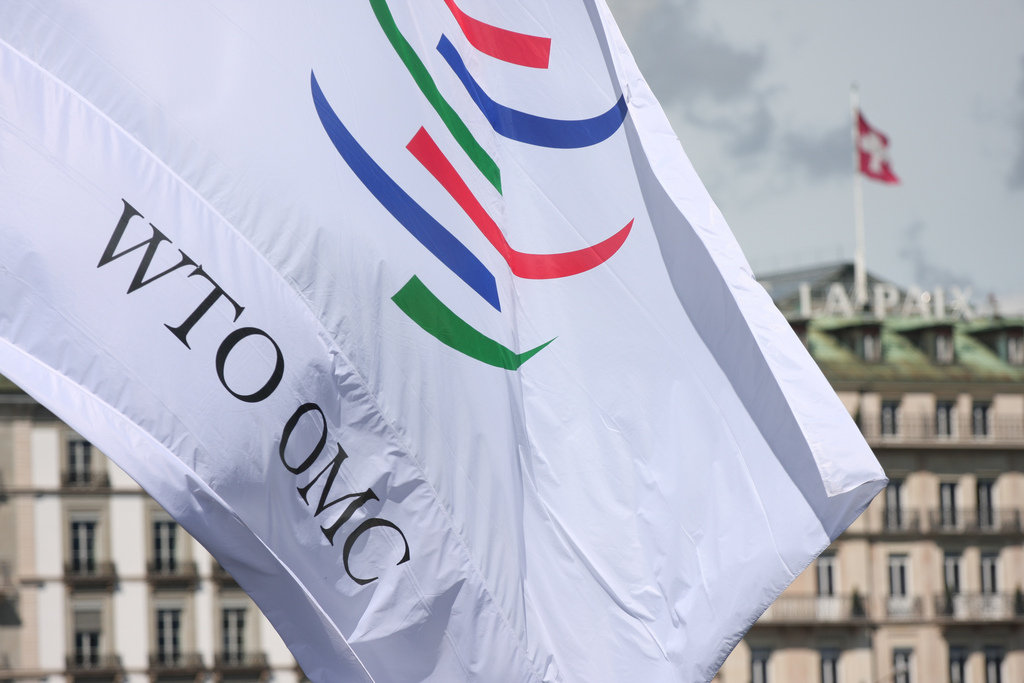Trade War Battles: The International Front
A surprise announcement from European Commission President Jean-Claude Juncker and President Donald Trump on Wednesday may be the first hint of a cease-fire in the trade war that the United States initiated when it imposed national-security-premised tariffs this spring. The initial outlook for Juncker’s visit was not good. Still, he and Trump unveiled plans to “work together toward zero tariffs, zero non-tariff barriers, and zero subsidies on non-auto industrial goods,” “to reform the WTO” and to “resolve” the recent steel and aluminum tariffs, among other collaborations.

Published by The Lawfare Institute
in Cooperation With

A surprise announcement from European Commission President Jean-Claude Juncker and President Donald Trump on Wednesday may be the first hint of a cease-fire in the trade war that the United States initiated when it imposed national-security-premised tariffs this spring. The initial outlook for Juncker’s visit was not good. Still, he and Trump unveiled plans to “work together toward zero tariffs, zero non-tariff barriers, and zero subsidies on non-auto industrial goods,” “to reform the WTO” and to “resolve” the recent steel and aluminum tariffs, among other collaborations.
These discussions are a step in the right direction, though it is too early to draw conclusions about either side’s commitments. Even less clear is how this engagement will affect the many ongoing cases at the World Trade Organization stemming from the U.S. tariffs.
Just last week, the United States launched separate disputes against five trading partners at the WTO. The disputes challenge actions those partners took in response to Trump’s tariffs on steel and aluminum imports. These filings bring the number of WTO dispute settlement proceedings precipitated by the steel and aluminum tariffs to a whopping 13.
Why is the United States suing its trading partners? The five partners targeted in the July 16 filings—the European Union (EU), Turkey, Canada, Mexico and China—each imposed retaliatory tariffs against a wide range of U.S. products as a response to the steel and aluminum tariffs. Prior to last week, eight governments—including a few of those named above—had begun WTO cases against the United States challenging the steel and aluminum tariffs as inconsistent with WTO rules. In other words: U.S. tariffs prompted eight cases against the United States, and retaliatory tariffs against the United States have prompted five cases by the United States against the partners imposing those tariffs. If that is not enough to make your head spin, it is certainly enough to keep the WTO dispute settlement staff very busy. And there is likely more to come.
The back-and-forth began in March, when Trump proclaimed an additional 25 percent tariff on steel imports and 10 percent tariff on aluminum imports coming from most countries under Section 232 of the Trade Expansion Act of 1962 (as amended). Section 232 permits the imposition of tariffs after an investigation to determine “the effects on the national security of imports” of the products in question but does not provide much guidance on how to make such a determination. The statute only loosely connects broad issues of economic welfare and domestic production with national security, a point highlighted at a Senate hearing on Thursday. The related regulations are equally unhelpful in defining what constitutes national security for this purpose. Regardless, the Commerce Department completed its investigations in January, concluding that the quantities and circumstance of steel and aluminum imports threatened to impair U.S. national security, and the president imposed tariffs shortly thereafter. In response, on the domestic front, industry representatives are challenging the constitutionality of Section 232 in U.S. courts. Congress is also considering options to step in and retract elements of the president’s tariff authority.
The issue under examination at the WTO is whether the tariffs are permissible as a matter of international law. China, India, the EU, Canada, Mexico, Norway, Russia and Switzerland have all challenged the U.S. tariffs by initiating consultations under the formal WTO dispute settlement process. Many of these governments are frequent participants in WTO dispute settlement, but for others initiating WTO disputes is rare. Switzerland last filed a dispute at the WTO in 2002, and it has been nearly 10 years since Norway last took such an action.
At least five WTO members have asked to join some or all of those cases as third parties. Still other countries have notified the WTO of their intent to retaliate or take other actions. Overall, reactions to the U.S. tariffs reveal widespread legal concern. More than 40 WTO members took the floor in Geneva in March to question the moves, including not only those states that have initiated WTO actions but also such major U.S. trading partners as Australia, Brazil, Japan and South Korea and smaller economies such as Singapore, Thailand, Kazakhstan, El Salvador and Paraguay.
The eight members that have filed under the dispute settlement provisions of the WTO raise a long list of U.S. measures that provide the basis for the tariffs, including but not limited to the presidential proclamations in March, April and May that put the tariffs into effect; the Commerce Department reports recommending presidential action; the Section 232 statute; and the corresponding regulations that provide the contours of national security considerations. The members claim that these measures violate several provisions of at least two WTO agreements.
Now, these governments’ retaliatory actions are being challenged by the United States. The U.S. complaints are short and to the point, with each claiming nearly the same thing: that the trade partner violates the basic WTO commitment of “most-favored-nation” treatment by imposing tariffs against the products in question coming from only the United States and that, with the exception of Mexico, the partner accords less favorable treatment to products originating in the United States than is provided in the partner’s WTO “schedule of concessions” (i.e., its list of reduced tariff rates). The United States previewed its WTO cases in a June statement, the background section of which said that the idea that any retaliatory duties could be justified was “ridiculous.” The statement explains: “Because the United States has not invoked and does not seek to benefit from the right to take emergency safeguard action under [the WTO agreements], no WTO Member has a right to retaliate with duties under an Agreement that does not even apply. Accordingly, the duties that have been announced on U.S. exports are completely without justification under international rules.”
How a WTO dispute settlement panel may treat these claims is unclear. Since the WTO’s creation in 1995 through last year, the United States had conducted only two Section 232 investigations. No presidential action was taken pursuant to those investigations, which makes the Trump tariffs the first Section 232 test case for the full panoply of WTO tools.
All this is complicated by the controversial “national security” exception to the WTO rules the United States has invoked. A March Lawfare post by Shannon Togawa Mercer and Matthew Kahn outlined the controversy and legal issues surrounding this exception. In its filings last week, the United States. took the position that Article XXI of the General Agreement on Tariffs and Trade, the relevant exceptions clause, takes national security matters out of play: “Issues of national security are political matters not susceptible to review or capable of resolution by WTO dispute settlement.” Moreover, regardless of which side wins, the WTO’s primary mechanism for enforcement is to permit retaliatory tariffs, which raises the question of whether the legal and ongoing tariff actions will more or less cancel each other out.
Time may be on everyone’s side. WTO cases do not often move quickly. Under the dispute settlement rules, members must first attempt to settle their disputes through consultations, which are now underway. If these fail, the member initiating the dispute may request that a dispute settlement panel be constituted. Each of the United States’ cases challenges a different measure by a different trading partner, which could mean that separate panels will hear each challenge. While consolidation is possible, it would be difficult given the complexities of the legal issues and the multiple interacting disputes.
If any of these cases get to the panel stage, a final outcome may be further complicated by another institutional battle taking place at the WTO Appellate Body. In recent months, WTO members have been unable to agree on a process for the appointment of new Appellate Body members. As a result, there may not be enough Appellate Body members to hear an appeal on these cases should they reach that point. Ironically, the U.S. move to sue its trading partners has given some commentators hope that the United States is not seeking to sink the WTO dispute settlement system as some previously thought given the recent strong U.S. criticisms of the Appellate Body.
None of this takes into account other recent tariffs the Trump administration imposed relating to China’s technology transfer measures and cyber theft, nor related WTO cases that the United States and China have undertaken. These tariffs, applied under Section 301 of the Trade Act of 1974, are the latest in the “three-digit sagas”—trade actions undertaken by the Trump administration on the basis of legal authorities with three-digit statutory references.
For now, attention is likely to shift back to the Commerce Department, which last week announced a new Section 232 investigation into imports of uranium and canceled one of its two days of scheduled hearings on another Section 232 investigation, this one regarding automobile and auto part imports. Several dozen WTO members recently raised concerns in Geneva about potential implications of tariffs on autos and auto part imports. If either of these additional Section 232 investigations leads to presidential action, the WTO dispute settlement system is likely to be even busier in the months (and years) ahead.





